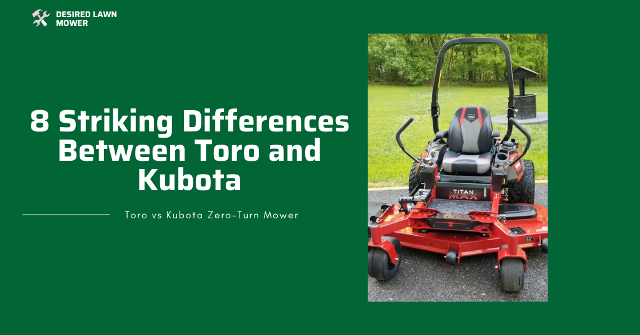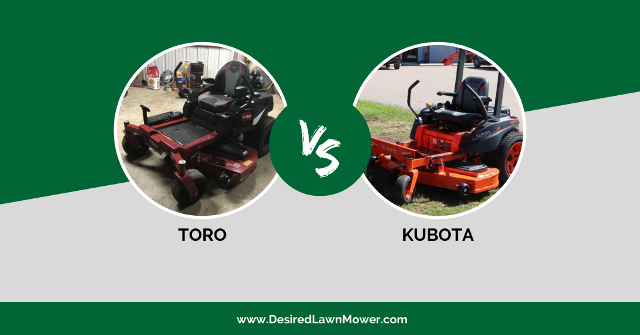Buying a zero-turn mower is much harder than selecting the dubbed toughest, fastest, or most long-lasting mowing machine. There are features you have to consider before striking a deal and bundling a zero-turn mower home, and the main reason for this is so that you don’t regret your decision when your expectations are not met.
Your requirements should be the top priority in deciding whether to purchase the Kubota or Toro zero-turn mower before seeking out aesthetics or your neighbor’s top suggestion. their suggested mower might be a good choice, to be fair, but how good will it be for you? Will it turn your lawn bald, slow down your business, or beat your spine blue and black? To avoid all that from happening, I have all the answers that will help you choose the best zero-turn mower to buy.
The Kubota and Toro zero-turns are both great deals worthy of firm handshakes, but this isn’t a one-mower-fits-all discussion. So, I will be highlighting both brands to show how they compare and contrast, and how they apply to your mowing needs. Read on!
A Concise Comparison: Toro Vs Kubota Zero-Turn

- Engine Specs and Power
The Kubota is much more established in a measure of power and power range. This means that you have a better shot at getting a much more powerful Kubota zero-turn mower in comparison to the Toro.
Kubota zero-turn engines vary from 19 to 36.9 horsepower depending on the grade of the mower— that is whether residential or commercial grades. For the residential smaller models, you get either Kawasaki, Briggs & Stratton, or Kohler engines in a range of 21 – 25 hp, which is quite efficient under 1.5 acres irrespective of how aggressive your terrain looks.
For the residential grade mowers that cut well over 1.5 acres of grass, you get 22 to 24 horsepower engines, and 21.1 to 36.9 horsepower on the commercial machines for much, much larger yards. You can also get the Kubota brand diesel option — for only the ZD1000 series — that struts into the show with a 19-22 hp motor if you’re the type to rapport with diesel.
On the other hand, the Toro zero-turn mower starts from 22 and ends at 26 horsepower which is mostly Kohler and in-house Toro engines except for one 23hp Kawasaki motor that happens to be paired with a 42-inch Toro Timecutter residential mower. The Toro home-based grades range from 22 – 24.5 hp, the high-grade residential mowers are standard 26hp either in Toro or Kohler engines, and the commercial-grade mowers 26hp all through.
If you have a measure of horsepower you specifically need, you could easily choose from the two brands which is the best for you.
Otherwise, go for the Kubota as it’s much better to maximize your options in cases like this –the tougher the engine, the tougher the mower.
- Deck Options and Deck Types
The Toro decks are all 10-gauge IronForged fabricated or stamped decks, with extra reinforcement on the higher residential and commercial grades. Deck sizes vary from 42 to 60 inches respectively. You get the IronForged fabricated bullnose decks on the larger mowers, which will deliver an exceptional quality thanks to the build and engineering of the deck. The Toro zero-turn decks are great for mulching and cut quite neatly on a larger perspective. So to say, you wouldn’t need to hover on a spot to get the job done.
On the Kubota zero-turn mowers, the decks are 10-gauge fabricated, stamped, or welded ranging from 42 to 54 inches for the smaller models, 48 to 60 inches for the high-grade residential models, and 58 to 72 for the commercial grades. They offer a much more unique level of variation so you can select the best to suit your needs.
- Cutting Quality
The cutting quality is highly dependent on the deck type and engine of the mower. Since the engine mostly powers the blades, the whole expectation rests on how tough your machine can mow. The cutting quality of Kubota zero-turn mowers is fair in comparison to the Toro. This is because the Toro is a little bit lighter, has more depth, and has better airflow that will propel the clippings adequately when you run over the yard.
Mulching is also a tough call because clippings don’t ruminate as they should under the heavy decks of the Kubota zero-turn mowers. So unless you go for the commercial-end models with a great amount of power to match the heaviness, you might leave stragglers on this brand when you’re dealing with tough grasses and wet terrain in full throttle.
If you’re a residential owner seeking to maneuver through obstacles while delivering clean sweeps and cuts, I suggest you go for the Toro zero-turn mowers– the decks weigh lighter and propel better airflow.
- Transmission and Speed
The whole idea of a zero-turn mower is to make mowing a lot easier to achieve, and speed is just one of the aspects lawn tenders look deeply into to fulfill that purpose.
The Kubota is well-known for its in-house transmission systems that present a tremendous amount of smooth rides. They all use the 2-HST with a gear reduction transmission system. Unless you’re going for the Z100 zero-turn beginner series which is the ZT-3100 hydro gear transmission. They start at a speed of 8 miles per hour and end at 11.2mph depending on the engines paired with the models.
However, the Toro is built with hydro-gear transmission systems varying from the ZT-2800 to the HG-3100 computing a speed of 7 to 9 miles per hour. Their best feature dependent on speed is the SmartSpeed system that allows the mowers to change momenta to the required velocity depending on what you want to achieve– that is either mow, tow, or trim.
Although the Kubota zero-turn mowers are much faster on paper, they’re not quite as maneuverable as the Toro models. This is because they weigh more than the Toro does, so dribbling through obstacles would be a little slower. You might not eye-capture the differences when you watch them side by side, but if you test-run the contesting brands, you’d easily notice how swiftly the Toro takes its turns.
- Convenience and Comfort
In terms of comfort, both models see eye to eye. This is because of the MyRide system that disconnects you from the frame of the mower so that when you run over a bump, you float over the shock waves instead of getting punched in the spine. This marvelous design is only found on the 42 to 60-inch Toro Timecutter, and the 54 & 60-inch Titan only. The seats of the mower vary in quality depending on the grade of the model. So for the lower grades, the standard seats are shorter by a few inches, less padded, and come without armrests. The higher you go up the scale, the more luscious it becomes.
On the other hand, Kubota put a lot of effort into their seats making them much more comfortable for you. For their low-grade residential models equivalent to that of the Toro zero-turn mower of the same grade, you get a fully padded suspension seat with armrests, which is mostly associated with high-grade residential or commercial models. So if you’re starting at the Z200 series – that is the low-grade residential series – you are settling on a great deal of comfort. The higher you go, the better suspension you get.
- Stability
In terms of stability, both mowers are again competitive. The only difference is that the Kubota models have larger tires by a 2-inch difference in comparison to the equivalent Toro models. So you might have a little more luck trudging your hills. However, since the Kubota is weighty, you might experience a little problem running against slopes. In this case, it’s a fair fight since the Toro is lighter and the Kubota rocks beefier tires. Overall, I’d go for the Toro MyRide mower if my yard was bumpy, and the Kubota because of the extra traction if my yard was hilly.
- Aesthetics
The first difference you’d notice on the Kubota residential zero-turn mower at first glance is the roll-over protection bar (Rops bar), which is quite generous considering you only find the bar on commercial zero-turn mowers. You also get 4 storage spaces for starters, in comparison to Toro zero-turn mower’s 2 storage spaces. Every other functional accessory can be purchased and attached to both brands suitably; you can buy a mulching kit, bagger, spreader, tow cart, etc. It all depends on you.
- Pricing
Toro zero-turn mowers are much cheaper in comparison to the Kubota z-turns. They start at $4,500 towards $9,000 – $10,000 with the high-grade commercial mowers at $18,500. The prices depend on your dealer, the type of engine, and the size of deck you choose.
With the Kubota, you start at $5,500 towards $9,000 – $12,000 and settle on a whopping $24,000 for the high-grade commercial zero-turn mower. In retrospect and for better comparison, for each equivalent grade of Toro and Kubota zero-turn, you add about $1,000 on the Toro to make the prices even. So, if your budget is the frame of your decision-making, the Toro will suit you better.
The Long-Awaited Summary!
Both the zero-turn mower brands are highly competitive thus the real debate as to which brand is better will rely on what you’re seeking for your yard. If you prefer a better cut quality over tantalizing power, then the Toro is your machine. Otherwise, if you’d prefer to slump comfortably in your machine for luscious padding to wrap around your back, I advise you to go for the Kubota. After all, you’ll do a great job with both zero-turn brands.
